Eye Spy
| January 24, 2023An insider’s report on the Chinese surveillance state
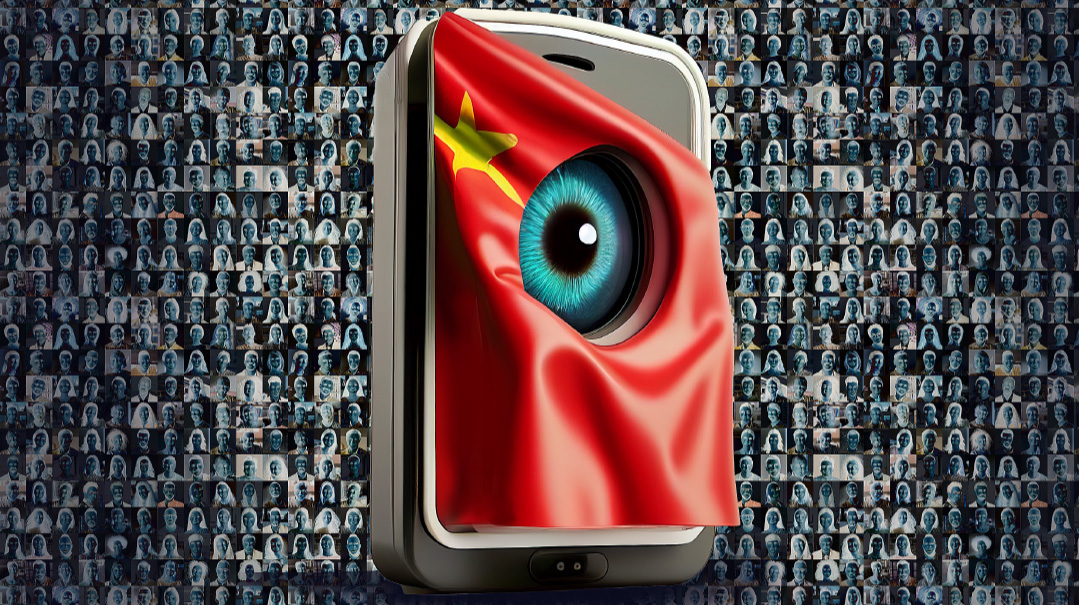
Digital Artwork: Menachem Weinreb
Photos: AP Newsroom
Geoffrey Cain entered China on a tourist visa, posing as a backpacker. His true intent: to observe the world’s most advanced all-seeing surveillance state up close.
Now that he’s seen the terrifying scope of China’s surveillance state, Cain has a warning for America. The Chinese state, he says, is spreading its long arm westward via a Trojan horse implanted in the phones of 138 million US citizens.
“See a terrorist, strike a terrorist!” shouted the policeman.
He was one of three burly counterterrorism officers at an outdoor market in the city of Kashgar in the far-western Chinese province of Xinjiang, training store owners how to bring down a terrorist. At the ring of a bell, they began the drill: strike hard, strike fast, and pin an imaginary terrorist on the ground.
It was December 2017 and Geoffrey Cain, an expert on the rise of China’s surveillance state, had entered the country on a tourist visa. He was posing as a backpacker and had arrived in Kashgar to see the world’s most advanced all-seeing surveillance state up close.
Cain, in the manner of tourists the world over, casually snapped a picture of the bizarre scene, and began walking away. But in true dystopian sci-fi fashion, one of the officers was wearing sunglasses with a built-in camera connected to SkyNet, China’s central surveillance database, through which the country’s 200 million AI-equipped security cameras are linked. Before Cain knew it, he was surrounded by police.
Cain had just experienced firsthand the reach of China’s surveillance program, which, in 2017, was still limited to Xinjiang and Tibet, though it has now been extended across China. SkyNet stores the DNA, voices, and social ranking of Chinese citizens, and the absence of details under Cain’s profile flagged him immediately as a foreigner.
Cain escaped with a warning, but he was only too aware that the outcome for the “terrorists” these locals were being trained to subdue would have been very different. He had been spotted with the most sophisticated and intrusive surveillance system the world had yet known, with Xinjiang as its testing ground and the Uighur Muslims as its first subjects. It would soon spread to the rest of China, and further fortify the high-tech police state the country has become under its strongman leader, Xi Jinping.
Now, Cain is warning that the Chinese state is spreading its long arm westward via a Trojan horse implanted in the phones of 138 million US citizens — TikTok.
The social media app, one of the fastest growing in the world, is American, but its parent company, ByteDance, is Chinese, and has a multiyear history of collaboration with the Chinese Ministry of Public Security. With its privacy policy explicitly stating that user data may be shared with its parent company, TikTok feeds a vast amount of sensitive information about the West’s Gen Z to the Chinese government.
There is no doubt that China views TikTok as an important weapon in its arsenal against the West. The proof is that China would take drastic steps to avoid separating the two companies.
A former TikTok employee summed it up for Cain: “It’s an American company on paper, but it’s a Chinese company underneath.”
The increasing popularity of TikTok for political campaigns is adding to the national security concerns already being raised, with FBI director Chris Wray adding his voice to those sounding the alarm.
Having seen up close the terrifying scope of China’s surveillance state, Geoffrey Cain has warned about the danger of a Chinese subsidiary playing a pivotal role in democratic processes, and applauds recent moves to legislate against TikTok.
“It’s about time,” he concludes.
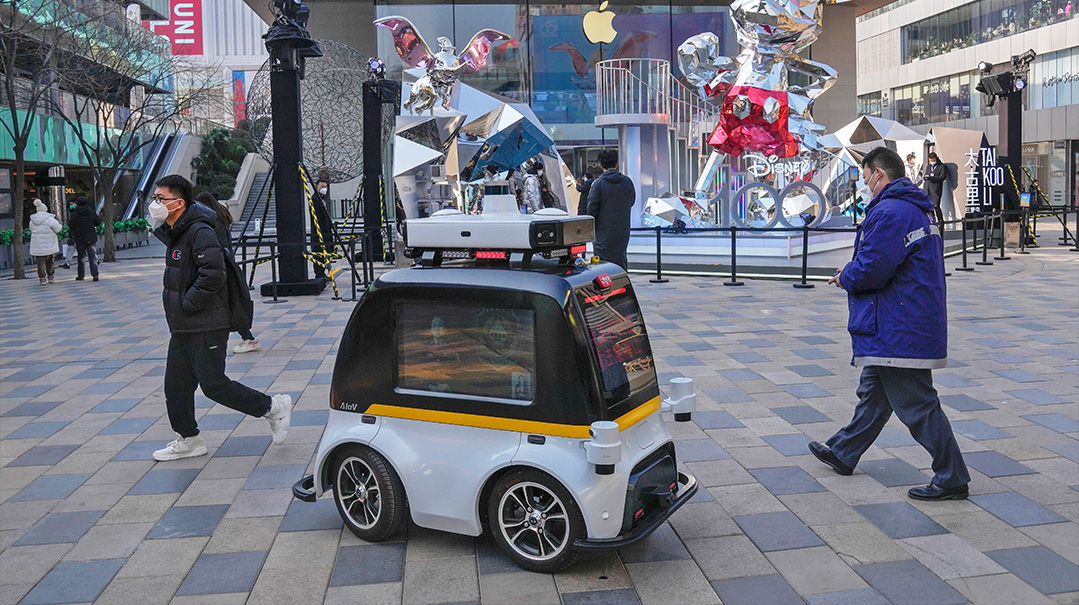
A police robot in Shanghai
Along the Silk Road
Geoffrey Cain’s journey into understanding that all-encompassing surveillance state began with an interest in maps, of which he’s a small-time collector.
Where others see ancient depictions of bygone empires, he sees a story still unfolding today: the harsh, resource-rich terrain of Eurasia, which stretches over the Balkans, Ukraine, Chechnya, Pakistan, and Central Asia, and remains conflict-ridden and difficult to govern until today.
Fascinated by the stark differences between organized nation-states governed by law and a region shaped by trade, conquest, and religion, Cain — a graduate of George Washington University and London’s School of African and Oriental Studies — has lived in the Middle East and Asia since 2008, experiencing the contrast firsthand.
He describes his fascination with the Silk Road, the thread of trading routes from Asia to Europe, over which silk went west to Europe and precious metals flowed east to China, and became particularly interested in China when it started to reach westward in the years after 9/11.
It was on a 2007 visit to China as a student that Cain first became aware of the country’s growing tech sector. He and his fellow students met the CEO of a tech company, who described a growing exuberance and self-confidence in China, particularly as it was beginning to rival the US in technological development.
Cain saw on a 2014 reporting trip to Beijing that those stirrings of pride had metastasized into palpable, self-styled nationalism with a distinct anti-Western flavor. A Chinese technology executive boasted to Cain that Google had exited China. Indeed, Google had shut down its Chinese search engine during a dispute over censorship.
“That doesn’t matter,” the executive assured Cain. “We have our own search engine now, Baidu. We have our own companies now. The world is changing, and I hope that Silicon Valley and the NSA [the US National Security Agency] will not rule forever.”
“But don’t you think if China wants to get to the level of Silicon Valley, it will have to open up the Internet?” Cain asked him. “So researchers can get the information they need to make good technology?”
“In China, our technology is connected to the future of our country. We don’t have strong separation of powers like in the US. Our only goal is to make China great. We want to stand as equals with the Americans, so that no one will look down on us again.”
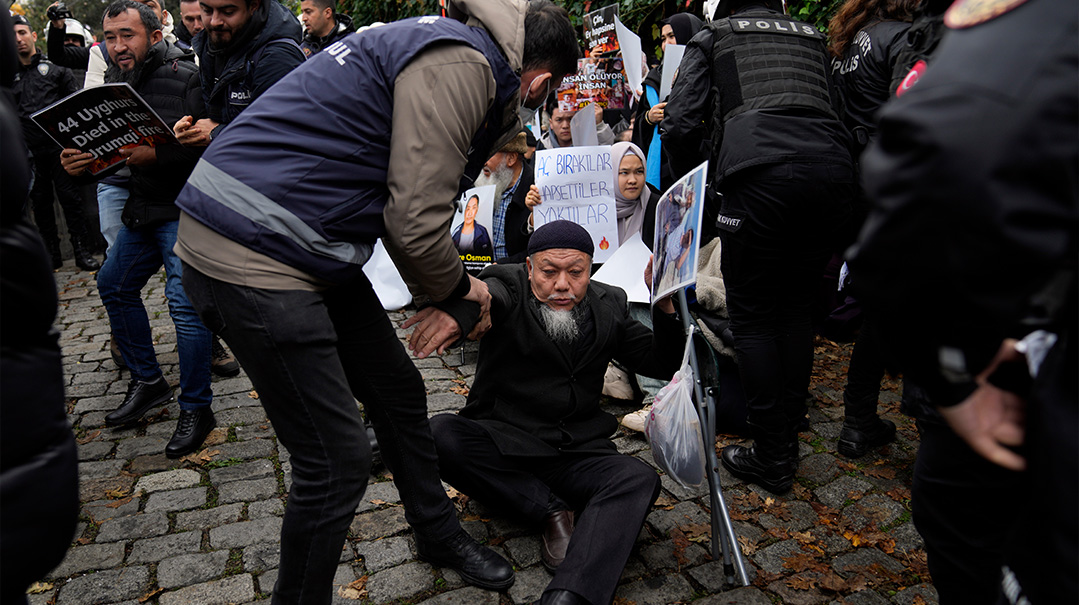
The Panopticon
The word that most accurately sums up China today is “panopticon,” which Cain describes as a circular prison in which one guard can see everyone, but no one can see the guard. Designed by English philosopher and social scientist Jeremy Bentham and the inspiration for George Orwell’s dystopian novel 1984, it derives from the word “pan,” meaning all, and “optic,” meaning seeing. Bentham posited that the perfect prison is one where all the cells are visible to a central guard tower, but the watched cannot see the watcher. So it is in China.
Surveillance technology has created a situation in which everyone knows they are being watched, but no one knows when or where. There are cameras on every street corner; estimates put the number of cameras in Chinese cities at 372.8 per 1,000 people. (The next most surveilled city, Indore in India, has 62.5 cameras per 1,000 people.) In addition to their quantity, these cameras are in a different class from those in London or Singapore: They are equipped with technology developed exclusively for a surveillance state and connected to China’s central surveillance database. Residents are required to scan their ID cards whenever they enter a public building, such as a school or supermarket.
The central database through which all this data runs, SkyNet, shares its name with a machine-learning program run by the US National Security Agency. But it was possibly also inspired by the malevolent super-intelligent computer network in the Terminator film and videogame series. Like its fictional namesake, China’s SkyNet has been invested with ever-evolving technological powers to increase the accuracy of its surveillance capabilities. According to the Chinese Communist Party tabloid Global Times, the system is fast enough to scan the entire population of China in under a second and allegedly has an accuracy rate of 99.8 percent — the ultimate high-tech baddie.
In 2020, Human Rights Watch warned of plans by the government’s Central Political and Legal Affairs Commission to integrate information harvested from online activity and existing surveillance infrastructure. The data, including residential addresses, family relations, travel and online shopping history, biometrics, and data from other government departments, combined with existing surveillance technology, is the basis on which the government assigns everyone a social ranking: trustworthy, average, or untrustworthy.
The third category is assigned to those who the system either predicts will commit a “crime” or considers a threat for political dissent.
Those unfortunate enough to be assigned “untrustworthy” status are effectively banned from living a normal life. They can be detained by police and may have difficulty getting into university or finding employment. They can be banned from booking international flights and traveling in premium classes domestically.
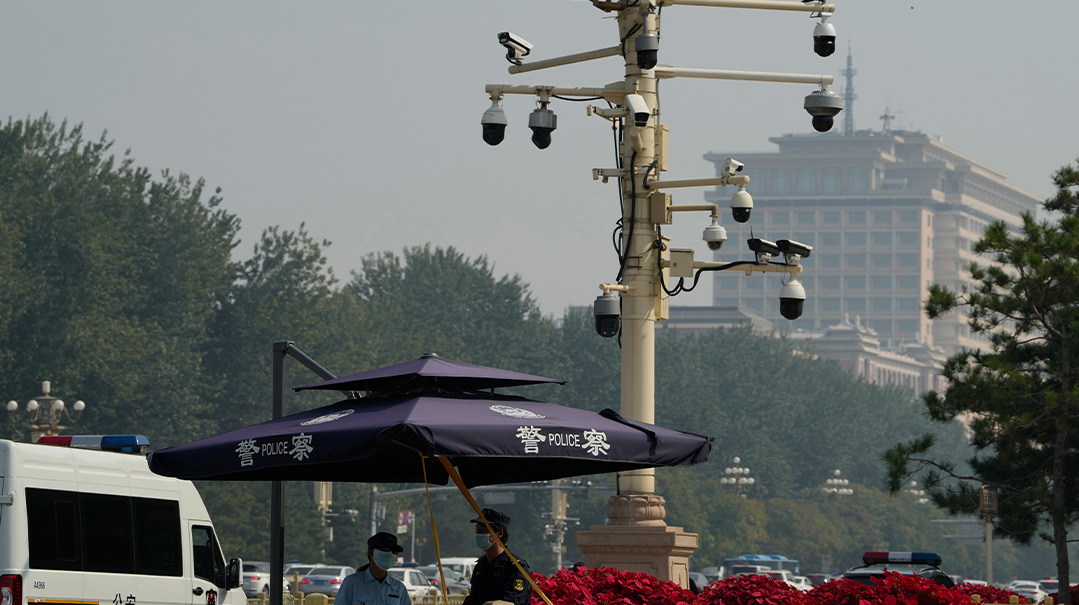
The camera array guarding Tiananmen Square in Beijing is only one of millions in China
Surveillance State
If China’s tech boom originated in places like Shenzhen near Hong Kong, the origins of the fearsome surveillance state enabled by that innovation lie thousands of miles to the west in Kashgar.
When Cain began planning a trip to China in 2017, several foreign journalists and diplomats tried to deter him. China, under the strongman rule of Xi Jinping, was turning back from its previous relative openness, and the target of the clampdown was the Muslim Uighur population of Xinjiang province in the far west.
“Wait till you get to Kashgar,” one journalist told him. “It’s apocalyptic.”
Even before he left for China, Cain received warning messages from journalists and human rights organizations: the Cambodian government, a Chinese ally, had learned of his plans, and a state-linked popular news website was splashing big on the story that Geoffrey Cain was heading for Xinjiang, where Uighur Muslims were rebelling against the government, with the intention to foment unrest, as a spy sent by an unnamed “superpower.”
Cain delayed his trip to Xinjiang by several days, hoping the paranoia would blow over, but it didn’t. Days stretched into months, and Cain grew restless. At a brief stop in Beijing, he met an American diplomat, and mentioned his next stop on his journalistic sojourn would be Xinjiang. Her reaction, “Don’t go there — they’ll follow you and detain you!” gave him an inkling of what he would be up against.
When Cain finally did get to Kashgar, in Xinjiang province, he met his guide, Mansur (whose name has been changed for his protection). Mansur’s wife was not at home for much of the day; she had been summoned, for no reason in particular, to hours-long classes studying and reciting government propaganda, a curriculum that would take a few months.
Those innocuous-sounding classes were part of the massive government effort to “reeducate” millions of Uighurs and strip them of their identity. The program — which has drawn harsh criticism across the West — includes the forced internment of more than a million people in a sprawling gulag archipelago of camps.
In a remote snowy region, away from cameras and informants, Mansur told Cain about “the Situation,” which was how Uighurs referred to the police state their communities had become — a vague doublespeak that would not incriminate them.
He told Cain that it was the connection to the outside world afforded to him by his job as a guide that kept him from going crazy.
Then Mansur outlined the three steps to creating a perfect police state (a phrase that became the title of Cain’s book) that China had followed. First was to identify an internal enemy and convince the rest of the citizenry that this fifth column was to blame for all of the country’s problems. A second stage was to deploy technology to monitor the suspects’ every action. Last, encourage informants and award every citizens a social ranking based on their loyalty to the state.
Scapegoat Search
When President George W. Bush declared the War on Terror following the 9/11 attacks, he could not have known that it would also be the genesis of China’s enhanced police state. The Islamist extremism that shook the West was the perfect excuse for Beijing’s clampdown on what it considered its own homegrown terrorist group — Uighur Muslims in the province of Xinjiang.
The region had prospered from an oil and construction boom from 2001 to 2009, but the profits were not distributed equally between the Han Chinese and Uighur Muslim populations, and resentment among the latter had begun to simmer. In 2009, a group of fringe radical Uighurs rioted in the region’s capital, Urumqi. The government responded with a harsh clampdown, shutting down Internet and communication lines, and many young Uighur men disappeared.
From 2014, public displays of religion, including beards and veils, were banned in public places. All inhabitants of Xinjiang were required to show ID cards in shopping malls and gas stations. Surveillance cameras proliferated. A 2022 estimate by cybersecurity advice website Comparitech put the number of cameras in Urumqi, Xinjiang’s capital, at 1.75 million. A mass DNA collection program was rolled out.
Those who had been flagged by SkyNet were summoned to “reeducation centers.” People were stopped at police checkpoints, their ID cards scanned, and questioned as to where they were going.
Slowly, city streets emptied out; the mere task of going for a walk or drive had become psychologically burdensome, and no one wanted to risk being harassed by the police. The government imposed restrictions on people leaving their homes, with travel to work, school, the grocery store, or visiting family deemed the only justifiable reasons to be outdoors. Xinjiang was put into lockdown years before Covid came into existence.
Propaganda abounded showing Uighurs as primitive empty-heads, interested only in exotic culture, contrasting them with the Han Chinese, who were depicted as modern, with successful careers. Services were segregated, with fast-track access accorded to the Han Chinese, and a slower, more bureaucratic version for Uighurs and other minorities.
China’s surveillance program was well underway when Xi Jinping rose to power in 2012. As a provincial governor, and then as vice president, he was a product of the Chinese Communist Party (CCP) establishment and had been the anointed successor since 2007. But he differed from his predecessor in his ambitions: He wanted to restore China’s glory in the international arena and return the country of 1.4 billion to its Communist past.
In his book, Cain describes Xi as representing a generation of socialists deeply uncomfortable with China’s newfound prosperity and the inequality this vast wealth generated. Xi felt China was losing its soul to corrupting market forces and believed it necessary to reverse the scourge of capitalism to restore China’s ideological core.
For all his Communist ideology and imperialistic nostalgia, Xi, a keen student of history, knew from China’s past that modernization was critical to the country’s success.
In order to cement his authority, Xi had the revolutionary might of technology, a weapon none of his predecessors had had at their disposal.
Between 2014 and 2016, the CCP’s counterterrorism tactics reached new levels of brutality and then in 2016, a new leader, Chen Quango, was installed in Xinjiang. Chen introduced new monitoring techniques, including “predictive policing” based on artificial intelligence technology (AI), with which a suspect could be detained based on a computer’s predictions that he or she was likely to commit a crime.
“That,” says Cain, “was the start of the surveillance state we know China as today. Xinjiang was the testing ground, and it spread to the rest of the country.”
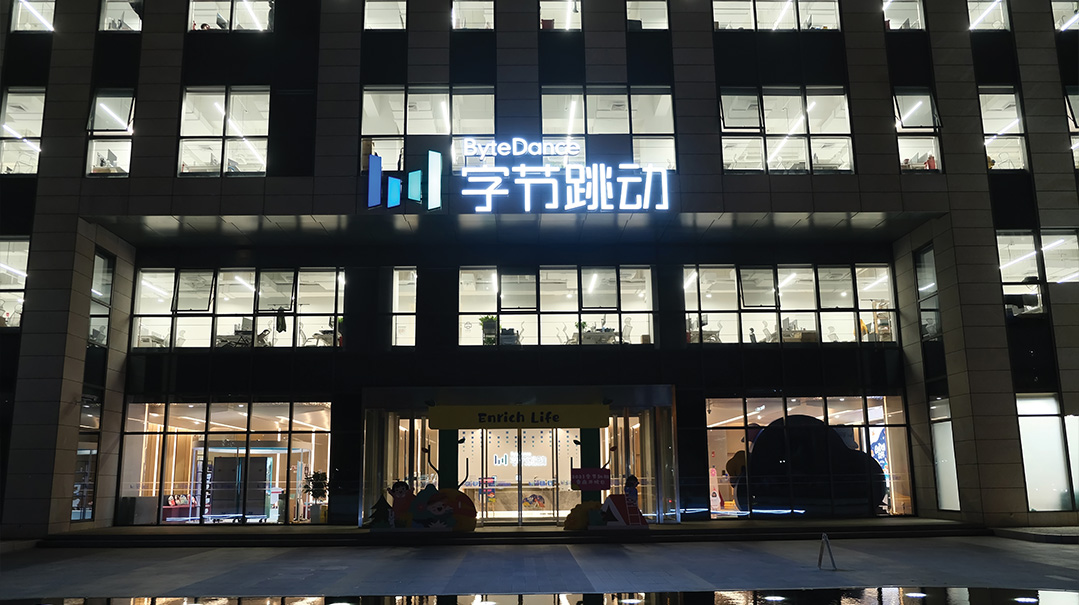
How much data on Western users is TikTok’s parent company ByteDance sharing with China’s spies?
Computer Vision
One of Cain’s contacts, a Uighur technology manager named Irfan, had landed a job as an IT manager in Urumqi to help set up one of the city’s first surveillance systems. Believing initially the task was to prevent crime and identify criminals, Irfan and his team scoured every street corner to find the best possible strategic location for cameras.
Two companies critical to this project are names that have appeared on national security watch lists in recent years: Hikvision, in which the government-owned company that installed the cameras had a 40 percent stake, and Huawei, which provided the switching system that powered the cameras.
Hikvision doesn’t just monitor Chinese citizens; it’s one of the largest surveillance camera providers in the world. The US alone has 600,000 Hikvision networks. Though there is currently no evidence that Hikvision feeds data gathered in foreign countries back to the Chinese state, the firm’s global prevalence has caused national security anxieties in other countries. In 2019, the US passed a law banning Hikvision from holding any contracts with the federal government.
Huawei has been banned by several Western countries, including the US and UK, from participation in the rollout of 5G. The US has banned the sale of Huawei cell phones.
With the cameras installed, Irfan and his staff sat in front of wall-mounted video screens to monitor their feeds and begin apprehending the criminals caught in their sights.
But the technology wasn’t advanced enough to apprehend thieves before they got away, so from 2010, their focus was on the use of artificial intelligence to recognize faces and behaviors and match them up with a national database of citizens.
The state was still missing a critical piece of the surveillance puzzle — data. They lacked the information to feed into the AI systems. And the solution didn’t come from the government. It came, Irfan confirmed to Cain, from the corporations.
Big Brother
The manipulation of technology for totalitarian aims had begun decades earlier, in 1998, with the establishment of MRA — Microsoft Research Asia. Built by Microsoft, with the aim of poaching the best Chinese minds to develop the technologies of the future, it went on to train over 5,000 AI researchers, thus enabling China to lay the groundwork for its own technological empire.
The Chinese government wished to capitalize on the huge economic benefits the Internet would bring but was deeply opposed to the prospect of citizens accessing information and utilizing the power of protest that could overthrow the one-party state, so from 2000, they required Internet service providers to ensure all information sent through their services adhered to the policies of the state.
Tech titans like IBM, Google, Microsoft, and Yahoo all duly signed up to this policy, and so the “Great Firewall’ was constructed; China’s Internet censorship system that ensured no outside influences could subvert the minds of its populace.
The Chinese didn’t merely ban Western technology and sources of information. They developed their own versions, which served a dual purpose — satisfying the craving of a new generation of Chinese for the technologies of the 21st century, and funneling information back to the state.
In 2011, WhatsApp launched in the US. That same year, China launched its own version, branded as WeChat, offering text messaging and the ability to send other people photos and voice messages. Within two years, it had 300 million users, a number it had taken Twitter and Facebook five and four years, respectively, to reach. Over time, it added extra functions for users — the ability to book appointments, order taxis (this was pre-Uber), pay at a local 7-11, and manage investments. Innocuously disguised as “conveniences,” these capabilities gathered and monitored ever more data from its users.
With Facebook and Twitter blocked in China, WeChat dominated lives there, and provided a massive online database of human activity.
“The ecosystem was coming together,” recalled Irfan. “We were building the large amount of data we needed for mass surveillance.”
In April 2013, Irfan was given an assignment, to install 4,000 servers in Xinjiang, which would store all WeChat metadata and phone numbers of the region’s population. At that point, Irfan and his colleagues began to get uneasy. Did the government really need everyone’s WeChat metadata to fight crime?
By the time the project was winding down, Irfan was becoming increasingly uncomfortable. He was one of only a handful of Uighurs working there, and the Han Chinese were suspicious of them, seeing them as second-class citizens who shouldn’t be trusted with sensitive state secrets. Irfan continued working there nonetheless, but feared China now had the capability to build an apartheid society based on technology.
By 2015, all the components of the surveillance state were in place in Xinjiang, complete with technology that could recognize faces, scan text messages and emails, and detect patterns in human conversations.
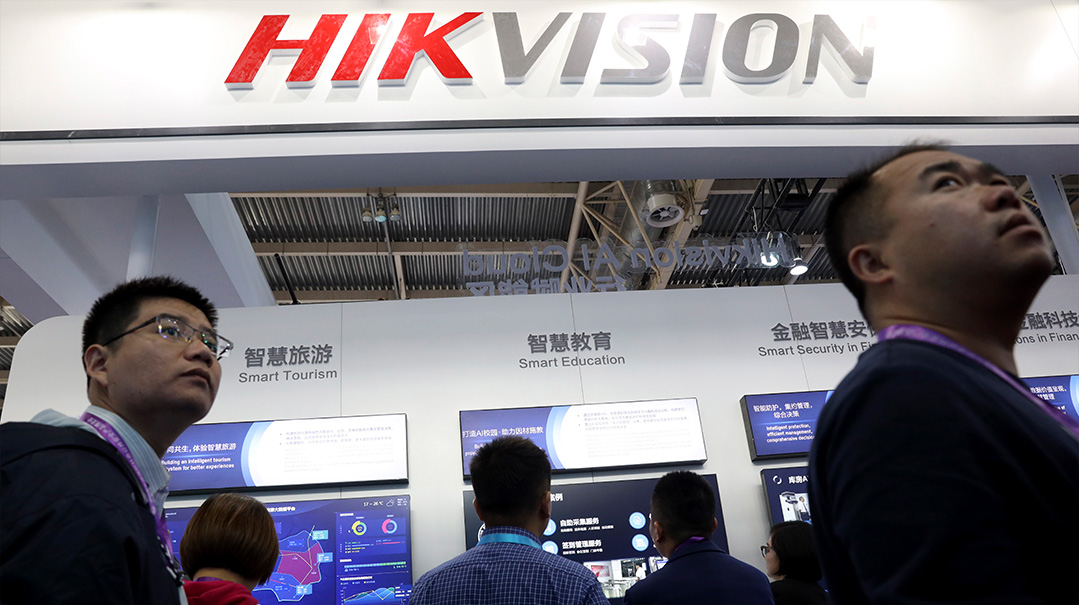
American authorities have moved to ban Hikvision from deploying cameras from sensitive areas of the US economy
Eye Spy
How much of that vast computing power is now deployed on Western users is unknown. Among the information TikTok hoovers up is its users likes, dislikes, contacts, and contact details. The obligation of its Chinese parent company to share any user data requested by the Chinese state means TikTok could be providing the CCP with a deep and detailed view of the social fabric of the next generation of Westerners.
Former Justice Department official John Carlin has warned that China may be manipulating what TikTok users see, using its vast platform to influence its mostly Gen Z audience.
A 2022 investigation by the Washington Post revealed that China was using software to mine Twitter and Facebook for information on Western officials, journalists, and academics. Erich Kron, a former security manager for a US military regional cybersecurity center, warns that “social media data can be used by nation-states for espionage in both the private sector, where they compete with other countries, and looking at public sector employees or potential political influencers.”
Fears that Hikvision, a Chinese company, may be subject to the same data-sharing laws, have prompted the US and UK to ban Hikvision cameras from any sensitive or safety-critical areas.
Huawei is another company of concern. With 5G predicted to underpin the technologies of the future, Western governments are getting increasingly squeamish about the prospect of a company with close links to the Chinese state building the foundations of the next generation of infrastructure. In 2021, the company was forced to deny reports in the Netherlands that it had access to telephone calls made on its network, including calls made by a former prime minister.
As well as reevaluating their political ties with China’s government, Western countries are now reevaluating their use of Chinese-made technologies that now dominate modern life.
Zero Tolerance
For Geoffrey Cain, the Covid pandemic’s arrival in China meant the nationwide rollout of a surveillance dystopia that had until now been confined to the minority-populated regions of Tibet and Xinjiang.
“Until Covid, only Xinjiang and Tibet could be described as ‘panopticons,’ ” he says. “Since the pandemic, the entire country has been turned into one.”
The creepiness of China’s draconian zero-Covid policy was symbolized by its ever-present technology. As late as April 2022, in Shanghai, China’s most populous city, a government-operated drone whirred over its locked-down streets, trumpeting, “Control your soul’s desire for freedom!”
From January 2020, China’s citizens were subject to the kind of lockdowns Xinjiang knows only too well. Using 500 million cameras, and health apps that every citizen is required to download, the state monitored the movements of every adult in China in the name of public health.
China assigns each citizen a health code, based on identity, contact information, and recent travel history. It is categorized into three colors — green for those who have had a negative Covid test in the past 24 or 48 hours, and yellow and red for those who are subject to restrictions.
At an event hosted by the China Institute at King’s College London in October, Ai Weiwei, a Chinese artist and dissident, warned, “The ‘health cards’ every citizen is required to hold reflect every conversation they have, every purchase they make, and their class status.”
Western observers eagerly asserted that the easing of restrictions after unprecedented recent protests shows that Xi’s supposedly iron grip on power is far weaker than it appeared. But Cain does not believe this shows any weakening of the regime.
“They made a tactical decision to ease restrictions instead of imposing a heavy-handed clampdown,” he says. “This was a relatively easy decision for the government, particularly because it was economically advantageous to reopen the country. They’ll save the tanks for a real crisis.”
Cain laments the relative ignorance of Western experts on Chinese geopolitics and estimates that for every hundred “experts,” three are the genuine article. Unlike Kremlinologists, which proliferated during the Cold War, Sinologists are harder to come by, partly because unlike the USSR, China is a far more closed society, and in recent years, it has become harder still to gain access to reliable information.
Even Cain, with his background and network of contacts, has found it increasingly difficult to mine intelligence, as China has become increasingly isolated and clamped down hard on anyone who leaks information unhelpful to the Xi regime.
Cain does not see the surveillance state being dismantled anytime soon. In a chilling fulfillment of the state’s intention, some in China trust government-assigned social rankings more than the word of their neighbors.
“The middle class likes it,” he says. “China is a low-trust country, and people use the social credit system as verification of the trustworthiness of a potential business partner, for example.”
Five years after Geoffrey Cain was first scanned by China’s SkyNet system in Kashgar, the reach and capacities of those technologies have made a quantum leap forward as China’s vast citizenry becomes grist for the country’s drive to master artificial intelligence technologies.
A decade after China’s leadership embarked on a mission to clamp down on dissent through the deployment of technology, those surveillance tools may now be turning millions of Chinese-made apps and cameras across the West into digital spies.
Beyond traditional espionage, exactly how China could deploy its mass surveillance tools isn’t clear. But the prospect of a Beijing with digital access to vast numbers of Americans is disturbing.
But even as American politicians prepare to move against TikTok, Xi Jinping doesn’t intend to back down in the face of Western threats against his tech sector.
“Technology is the sharp arm of the state,” says Cain, “and Xi Jinping — as a student of the history of China’s decline and the West’s ascent — sees AI and facial recognition technology as China’s route to return to dominance.”
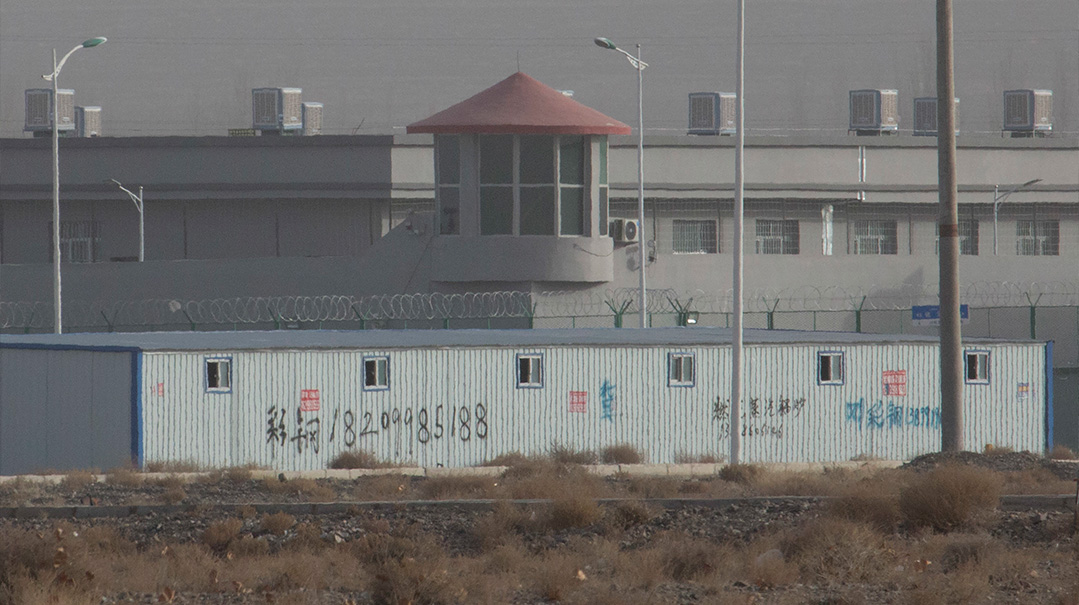
More than a million Uyghurs are in camps dedicated to their “re-education”
A Painful Echo
China’s detention of some one million Uighurs in detention camps in the far-western province of Xinjiang echoes some of the 20th century’s most painful chapters.
The Uighurs are not ethnic Chinese but a Turkic people, spread across Central Asia. They number some 13.5 million people worldwide, but the vast majority, around 11 million, reside in China’s sparsely populated Xinjiang province, approximately the size of Alaska.
Since 2017, the Chinese government has detained between 800,000 and two million Uighurs in what it calls “vocational education and training centers.” Most of those held there have not been charged with crimes; they seem to have been targeted for arousing state suspicion through such activities as visiting countries like Turkey and Afghanistan, sending texts containing Koranic verses, and having more than three children.
A UN human rights office interviewed dozens of former detainees who fled China and reported widespread “patterns of torture or other forms of cruel, inhuman, or degrading treatment” in the camps, with people being subject to harsh interrogations and sleep deprivation. Uighurs were forced to pledge loyalty to the CCP and renounce Islam. Female detainees shared stories of abuse.
Aside from mass detention in the camps, Chinese authorities have also afflicted the Uighur population through other means, such as forced sterilization, forced labor, consignment of children to orphanages, and constant police surveillance and harassment.
China at first denied the existence of the detention camps. By late 2018, officials began to acknowledge that Uighurs were being sent to facilities that would teach Uighurs the Mandarin dialect, Chinese laws, and vocational skills; as well as prevent them from being influenced by extremist ideas, to “nip terrorism in the bud.”
Beijing claims to have closed the camps in 2019, but international human rights activists and researchers have documented through satellite images, individual testimonies, and leaked government documents that detention is ongoing. Government officials and media outlets have characterized Western reports about the camp as the work of “anti-China forces.” Muslim-majority countries with important trade relationships with China, such as Pakistan and Saudi Arabia, have remained notably silent about the abuses.
—Source: Council on
Foreign Relations
(Originally featured in Mishpacha, Issue 946)
Oops! We could not locate your form.







